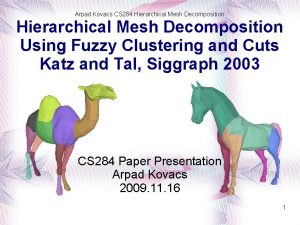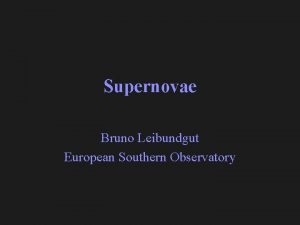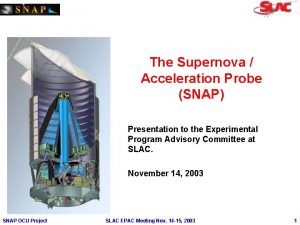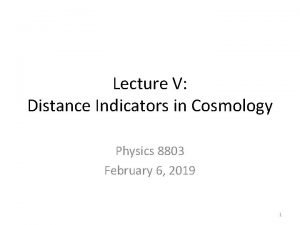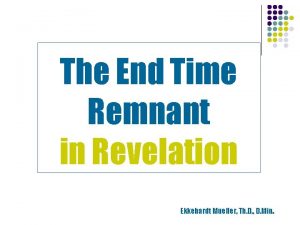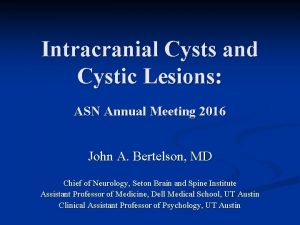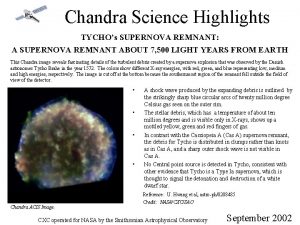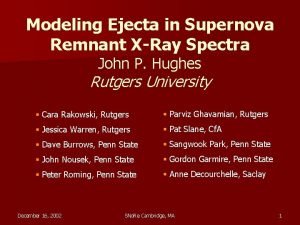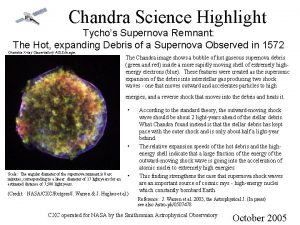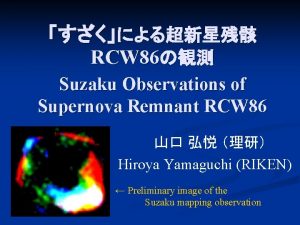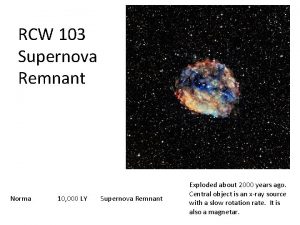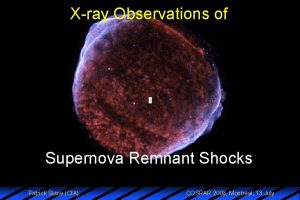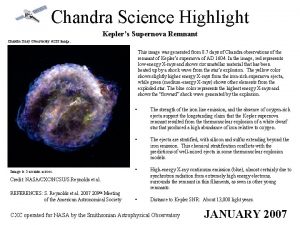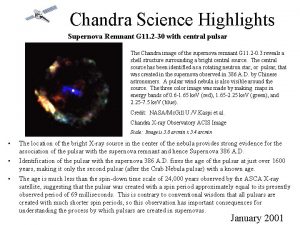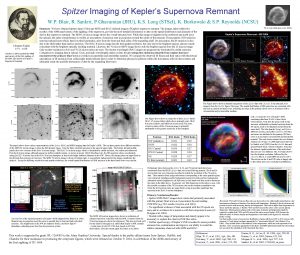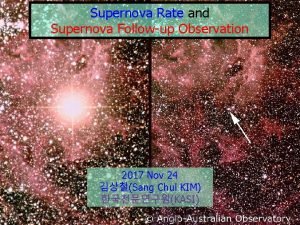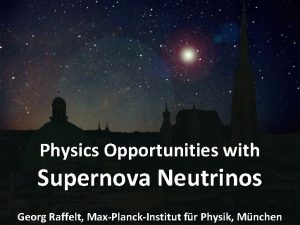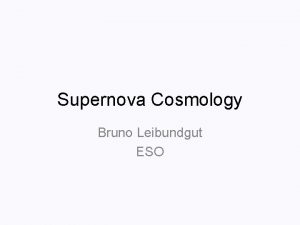The supernova remnant G 284 3 1 8



















- Slides: 19

The supernova remnant G 284. 3 -1. 8 and the Xray binary 1 FGL J 1018. 6 -5856 Blagoy Rangelov George Washington University Collaborators: Brian Williams (NASA GSFC/CRESST/USRA) Oleg Kargaltsev (George Washington University) George Pavlov (Pennsylvania State University)

Outline Overview Analysis of G 284. 3 -1. 8 (G 284) 1 FGL J 1018. 6 -5856 (J 1018) Spectral/spatial analysis Binary evolution Summary Based on ar. Xiv: 1506. 02665 (in press, Ap. JL)

X-ray Binaries

Gamma-ray Binaries An et al. (2013)


G 284 & J 1018


G 284 72 ks Chandra Obs. (ours) 105 ks XMM Obs. (PI: De Luca)

North Region Model: phabs x vpshock Abundances: O=1 Ne = 1. 19 Mg = 1. 06 Si = 0. 19 Fe = 0. 24 k. T = 0. 67 ke. V �� = 4. 6 x 1012 cm-3 s Chandra, XMM MOS 2

West Region Model: phabs x vpshock Abundances: O=1 Ne = 1. 30 Mg = 4. 53 Si = 1. 50 Fe = 0. 97 k. T = 0. 92 ke. V �� = 1. 0 x 1011 cm-3 s Chandra, XMM MOS 1, XMM MOS 2

West region rich in Mg, spectra and abundances similar to N 49 B in LMC (Park et al. 2003), another SNR with Mg-rich ejecta. Nucleosynthesis models produce significant amounts of Mg in explosions of massive (> 25 M⊙).

1 FGL J 1018

1 FGL J 1018 An et al. (2015)

1 FGL J 1018 Chandra observations at binary phase 0. 42 and 0. 67. Power-law spectrum: n. H = 9 x 1021 cm-2 Γ ≃ 1. 75 It’s a binary: 16. 6 d period Optical counterpart O 6 V((f)) star M=30 M⊙ One of only two high-mass ɣ-ray binaries inside an SNR (SS 433 in W 50).

Point Source Analysis Profile vs. PSF model

Point Source Analysis


Binary Evolution Binary evolution code (Hurley+ 2002) Grid of 80, 000 simulations: M 1 = 10 -35 M⊙, M 2 = 12 -50 M⊙, M 2 > M 1. P=5 -50 d, e = 0 -0. 9. Best-fit reproduction with M 1 = 13. 4 M⊙, M 2 = 26. 7 M⊙, P = 18 d, e = 0. 57. Results in 2. 2 M⊙ NS.

Summary SNRs can reveal information about the progenitor system. 1 FGL J 1018. 6 -5856 has a power-law spectrum. Hint of extended emission. Ejecta in SNR appear Mg-rich, very similar to LMC SNR N 49 B Nucleosynthesis models favor massive stars > 25 M⊙. Binary evolution models consistent with a heavy neutron star as compact object. ; SN progenitor ≃ 27 M⊙.
 284 371 in word form
284 371 in word form When diocletian took power in a.d. 284, he
When diocletian took power in a.d. 284, he 284 ad
284 ad 284
284 Round 284 to the nearest ten.
Round 284 to the nearest ten. 284
284 284-pwrm
284-pwrm 2812840027
2812840027 Cs 284
Cs 284 Bruno leibundgut
Bruno leibundgut Supernova
Supernova Supernova acceleration probe
Supernova acceleration probe Supernova mentor
Supernova mentor Steris decontamination sinks
Steris decontamination sinks Supernova spectra
Supernova spectra Ekkehardt mueller
Ekkehardt mueller Remnant radiation
Remnant radiation Remnant in the bible
Remnant in the bible Remnant radiation
Remnant radiation Cavum vellum interpositum
Cavum vellum interpositum








